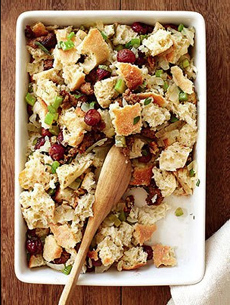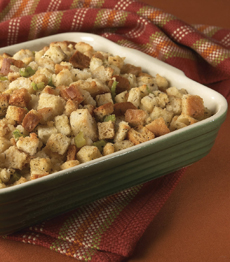FOOD 101: Is It Stuffing Or Dressing?
|
|
What’s the difference between stuffing and dressing, readers ask?
Stuffing the cavity of animals with another dish is an ancient practice. The earliest documentary evidence is the Roman cookbook, “De Re Coquinaria,” “On Cooking, from about 100 C.E. (It is still in print, in English translation. Get a copy on Amazon.com.) The book contains recipes for stuffed chicken, hare, pig, and, yes, dormouse. In addition to stuffing the body cavity of birds, fish and mammals, various cuts of meat are stuffed after they have been deboned, or a pouch has been cut into them. Examples include stuffed chicken legs, stuffed pork chops and stuffed breast of veal. Vegetables can also be stuffed, from cabbage, where the individual leaves are stuffed and rolled, to potatoes and zucchini, where the flesh is removed, combined with other ingredients, and stuffed back into the shell. Names for stuffing in the English language evolved as well. Wikipedia mentions farce ( |
|
|
WHAT’S IN STUFFING? Most of the stuffings described in “De Re Coquinaria” consist of vegetables, herbs and spices, nuts, spelt (also known as dinkel wheat or hulled wheat) or other grain. Other popular ingredients included brains, chopped liver and other organ meats. Similar ingredients are still used today. The main difference is that bread is often the base into which the other ingredients are mixed. Turkey stuffing usually consists of day-old (or older) bread, cut into cubes or dried into croutons, mixed with celery, onion, poultry seasoning, salt, pepper and herbs such as sage or summer savory. Add-ins range from fruit and oysters to giblets and pancetta. |
||
|
WHY ARE BOTH “STUFFING” & “DRESSING” USED IN THE U.S.? There is a difference. “Stuffing” is self-explanatory: The ingredients are stuffed into the cavity. But in the South, “dressing” is the prevailing term, even if the bird is stuffed in exactly the same way. Why? Because old Southern tradition dictated that holiday fowl be hunted and cooked on the day of the feast itself. It was a time crunch to get the bird cleaned and cooked in time for dinner, and a hollow bird cooks faster than a stuffed bird. Thus, the side dish was not stuffed into the bird, but cooked alone. In the process, stuffing is cooked at a higher temperature for a longer period than a separate pan of dressing; so it is usually drier. Older dressing recipes were created to have more of a sauce-like consistency, so it could be poured over the food. So if the discussion arises at your Thanksgiving dinner, consider yourself prepared! |
 Cornbread stuffing dressed up with sundried tomatoes, fresh sage and grapes. Photo courtesy Bella Sun Luci. |
|
|
|
||



